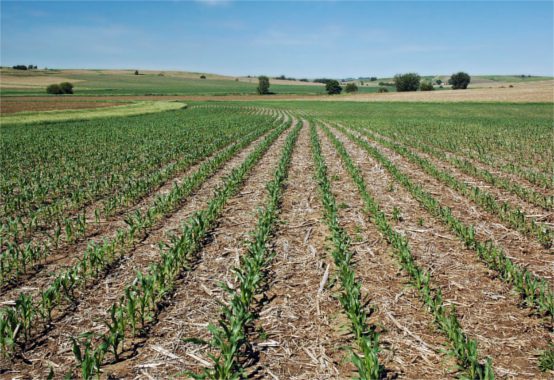Fighting Global Warming with Plowshares to Planting Sticks

10,000 years ago, two methods of planting competed to ring in the age of agriculture. Some used planting sticks to perforate the ground, burying their seeds in the created holes. Others dragged a scratch plow across their fields, planting their seeds in the resulting furrow. As draft animals were domesticated to pull increasingly sophisticated blades, the tillage-based method won out, and civilizations rose on the strength of their plows. Yet by the 1930s, the cost of continually dragging up the soil finally came to be paid as American topsoil simply blew away in the wind, leaving a Dust Bowl in its wake.
Starting in 1974, the United States started promoting a radical new method of farming, one spiritually descended from the lost planting sticks. “No-till” farming dramatically reduces the disturbance of the soil, puncturing it to set the seeds but leaving the residue on top intact. Since that year, the UN estimates that no-till farming has reduced American greenhouse gas emissions by the equivalent of removing 50 million cars from the roads, according to the Washington Post‘s calculations. Cropland erosion in the United States has been reduced by nearly 40 percent since the 1980s, mostly as a result of increased no-till farming. As of 2009, 10 percent of all U.S. farmland is under strict no-till, and 35 percent has some degree of no-till operations.
No-till farming replaces the traditional plows with specialized machines for planting. However, since plows also tear up and bury weeds, it usually uses increased herbicides to kill unwanted plants. In fact, the advent of new herbicides in the 1940s enabled the development of no-till techniques in the first place, though there is increased risk of herbicide resistance. While there is certainly environmental concern over herbicide runoff, the increased water retention of no-till fields may be able to mitigate some of that concern by not sending as much waste water out in the first place. Also, as an excellent overview of no-till farming in Scientific American suggested, herbicide resistance could be countered by adopting techniques from the organic farming movement, like crop rotations.
According to some studies, no-till farming can reduce soil erosion of croplands by 90-100 percent. Why, then, is it only fully implemented on 10 percent of U.S. farmland, and why does North America account for the lion’s share of no-till farming? For one thing, it’s new, and farmers don’t have any experience with a very different technique of farming. In fact, there is evidence that switching over is risky, and an overhasty and ill-fated switch could ruin a crop or a farm. For another, it is expensive. The new machines can cost more than $100,000 each. And because the heavy topsoil takes longer to dry out after the winter, it can reduce planting seasons, thus crop yields, especially for America’s super crop, corn in norther climes.
However, this is not one more example of one more green policy that’s sustainable for the environment but not for the practitioners. Because no-till farmers have to do fewer than half as many tractor passes over their fields as traditional plowing, they use 50 to 80 percent less fuel and half as much labor. Overall, once the expensive machinery has been purchased, no-till farming is significantly cheaper to run, slashing capital and operating costs in half. Moreover, the very moisture retention that shrinks the planting season also provides a robust protection in drought conditions. According to a recent UN report, during a devastating 2012 drought in Kazakhstan that cut overall wheat yields in half, no-till wheat produced three times the yields of conventionally farmed fields.
Because of the novelty, and the significant up-front costs, no-till agriculture usually requires governmental encouragement to get going, whether in a new country or a new farm. Given its significant potential benefits in preserving our land for the generations to come, while sequestering carbon in the ground where it belongs, in rich, organic materials instead of the atmosphere, and given the sustainable economics of a technique that costs less than half as much to perform, no-till farming sounds like a quintessential example of when government encouragement can be called for.
As the farm bill is hashed out in conference in the coming days, perhaps this is the perfect time to take the billions being handed out to the slickest ethanol and sugar lobbies, and repurpose some of it to subsidize those steep upfront costs of no-till conversion. That sounds like money much better spent.
Comments